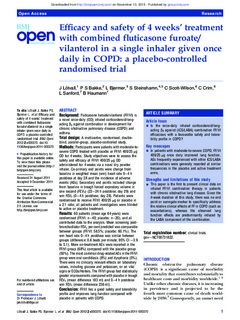| dc.contributor.author | Lotvall, J | |
| dc.contributor.author | Bakke, Per S. | |
| dc.contributor.author | Bjermer, Leif | |
| dc.contributor.author | Steinshamn, Sigurd Loe | |
| dc.contributor.author | Scott-Wilson, C | |
| dc.contributor.author | Crim, Courtney | |
| dc.contributor.author | Sanford, L | |
| dc.contributor.author | Haumann, B | |
| dc.date.accessioned | 2015-11-10T11:28:54Z | |
| dc.date.accessioned | 2015-11-23T09:32:02Z | |
| dc.date.available | 2015-11-10T11:28:54Z | |
| dc.date.available | 2015-11-23T09:32:02Z | |
| dc.date.issued | 2012 | |
| dc.identifier.citation | BMJ Open 2012, 2(1) | nb_NO |
| dc.identifier.issn | 2044-6055 | |
| dc.identifier.uri | http://hdl.handle.net/11250/2365144 | |
| dc.description.abstract | Background: Fluticasone furoate/vilanterol (FF/VI) is a novel once-daily (OD) inhaled corticosteroid/long-acting β2 agonist combination in development for chronic obstructive pulmonary disease (COPD) and asthma.
Trial design: A multicentre, randomised, double-blind, parallel-group, placebo-controlled study.
Methods: Participants were patients with moderate-to-severe COPD treated with placebo or FF/VI 400/25 μg OD for 4 weeks. Study objectives were to assess the safety and efficacy of FF/VI 400/25 μg OD administered for 4 weeks via a novel dry powder inhaler. Co-primary end points were change from baseline in weighted mean (wm) heart rate 0–4 h postdose at day 28 and the incidence of adverse events (AEs). Secondary end points included change from baseline in trough forced expiratory volume in one second (FEV1) (23–24 h postdose; day 29) and wm FEV1 (0–4 h postdose; day 28). Patients were randomised to receive FF/VI 400/25 μg or placebo in a 2:1 ratio; all patients and investigators were blinded to active or placebo treatment.
Results: 60 patients (mean age 64 years) were randomised (FF/VI: n=40; placebo: n=20), and all contributed data to the analysis. Mean screening post-bronchodilator FEV1 per cent predicted was comparable between groups (FF/VI: 58.5%; placebo: 60.1%). The wm heart rate 0–4 h postdose was similar between groups (difference: 0.6 beats per minute; 95% CI −3.9 to 5.1). More on-treatment AEs were reported in the FF/VI group (68%) compared with the placebo group (50%). The most common drug-related AEs in the FF/VI group were oral candidiasis (8%) and dysphonia (5%). There were no clinically relevant effects on laboratory values, including glucose and potassium, or on vital signs or ECGs/Holters. The FF/VI group had statistically greater improvements compared with placebo in trough FEV1 (mean difference 183 ml) and 0–4 h postdose wm FEV1 (mean difference 236 ml).
Conclusion: FF/VI has a good safety and tolerability profile and improves lung function compared with placebo in patients with COPD. | nb_NO |
| dc.language.iso | eng | nb_NO |
| dc.publisher | BMJ Publishing Group | nb_NO |
| dc.title | Efficacy and safety of 4 weeks' treatment with combined fluticasone furoate/vilanterol in a single inhaler given once daily in COPD: a placebo-controlled randomised trial | nb_NO |
| dc.type | Journal article | nb_NO |
| dc.type | Peer reviewed | en_GB |
| dc.date.updated | 2015-11-10T11:28:54Z | |
| dc.source.volume | 2 | nb_NO |
| dc.source.journal | BMJ Open | nb_NO |
| dc.source.issue | 1 | nb_NO |
| dc.identifier.doi | 10.1136/bmjopen-2011-000370 | |
| dc.identifier.cristin | 1024287 | |
| dc.description.localcode | This is an open-access article distributed under the terms of the Creative Commons Attribution Non-commercial License, which permits use, distribution, and reproduction in any medium, provided the original work is properly cited, the use is non commercial and is otherwise in compliance with the license. See: http://creativecommons.org/licenses/by-nc/2.0/ and http://creativecommons.org/licenses/by-nc/2.0/legalcode. | nb_NO |
